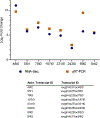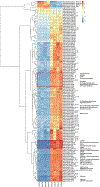RNA-Seq used to identify ipsdienone reductase (IDONER): A novel monoterpene carbon-carbon double bond reductase central to Ips confusus pheromone production
- PMID: 33388375
- PMCID: PMC7909325
- DOI: 10.1016/j.ibmb.2020.103513
RNA-Seq used to identify ipsdienone reductase (IDONER): A novel monoterpene carbon-carbon double bond reductase central to Ips confusus pheromone production
Abstract
The pinyon ips beetle, Ips confusus (LeConte) is a highly destructive pest in pine forests in western North America. When colonizing a new host tree, I. confusus beetles coordinate a mass attack to overcome the tree's defenses using aggregation pheromones. Ips confusus, as with other Ips spp. beetles, biosynthesize ipsdienol and ipsenol in a specific enantiomeric blend and ratio as aggregation pheromones. While several of the initial steps in the pheromone biosynthetic pathway have been well defined, the final steps were unknown. We used comparative RNA-Seq analysis between fed and unfed male I. confusus midgut tissue to identify candidate genes involved in pheromone biosynthesis. The 12,995 potentially unique transcripts showed a clear separation based on feeding state. Differential expression analysis identified gene groups that were tightly connected. This analysis identified all known pheromone biosynthetic genes and suggested a novel monoterpene double bond reductase, ipsdienone reductase (IDONER), with pheromone biosynthetic gene expression patterns. IDONER cDNA was cloned, expressed, and functionally characterized. The coding DNA sequence has an ORF of 1101 nt with a predicted translation product of 336 amino acids. The enzyme has a molecular weight of 36.7 kDa with conserved motifs of the medium chain dehydrogenases/reductase (MDR) superfamily in the leukotriene B4 dehydrogenases/reductases (LTB4R) family. Tagged recombinant protein was expressed and purified. Enzyme assays and GC/MS analysis showed IDONER catalyzed the reduction of ipsdienone to form ipsenone. This study shows that IDONER is a monoterpene double bond reductase involved in I. confusus pheromone biosynthesis.
Keywords: Bark beetle; Ips confusus; Ipsdienone; Ipsenone; Monoterpene carbon-carbon double bond reductase; Pheromone; Pinyon ips; Prostaglandin reductase; RNA-Seq.
Copyright © 2021 Elsevier Ltd. All rights reserved.
Conflict of interest statement
Figures






Similar articles
-
Myrcene hydroxylases do not determine enantiomeric composition of pheromonal ipsdienol in Ips spp.J Chem Ecol. 2008 Dec;34(12):1584-92. doi: 10.1007/s10886-008-9563-7. Epub 2008 Nov 26. J Chem Ecol. 2008. PMID: 19034575
-
Ipsdienol dehydrogenase (IDOLDH): a novel oxidoreductase important for Ips pini pheromone production.Insect Biochem Mol Biol. 2012 Feb;42(2):81-90. doi: 10.1016/j.ibmb.2011.10.009. Epub 2011 Nov 11. Insect Biochem Mol Biol. 2012. PMID: 22101251
-
Two regulatory mechanisms of monoterpenoid pheromone production in Ips spp. of bark beetles.J Chem Ecol. 2009 Jun;35(6):689-97. doi: 10.1007/s10886-009-9652-2. Epub 2009 Jun 25. J Chem Ecol. 2009. PMID: 19554371
-
Pheromone production in bark beetles.Insect Biochem Mol Biol. 2010 Oct;40(10):699-712. doi: 10.1016/j.ibmb.2010.07.013. Epub 2010 Aug 19. Insect Biochem Mol Biol. 2010. PMID: 20727970 Review.
-
Biochemistry and molecular biology of de novo isoprenoid pheromone production in the Scolytidae.Annu Rev Entomol. 2003;48:425-53. doi: 10.1146/annurev.ento.48.091801.112645. Epub 2002 Jun 4. Annu Rev Entomol. 2003. PMID: 12460936 Review.
Cited by
-
Hotter droughts alter resource allocation to chemical defenses in piñon pine.Oecologia. 2021 Dec;197(4):921-938. doi: 10.1007/s00442-021-05058-8. Epub 2021 Oct 17. Oecologia. 2021. PMID: 34657177 Free PMC article.
References
-
- Benjamini Y, & Hochberg Y (1995). Controlling the False Discovery Rate: A Practical and Powerful Approach to Multiple. In Source: Journal of the Royal Statistical Society. Series B (Methodological) (Vol. 57).
Publication types
MeSH terms
Substances
Grants and funding
LinkOut - more resources
Full Text Sources
Other Literature Sources
Research Materials
Miscellaneous

